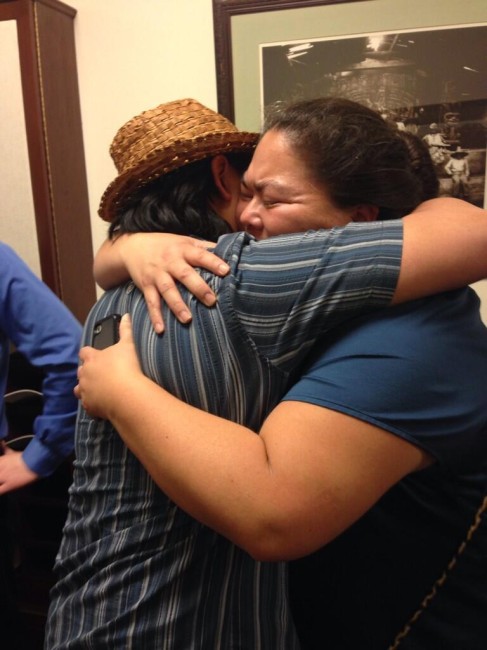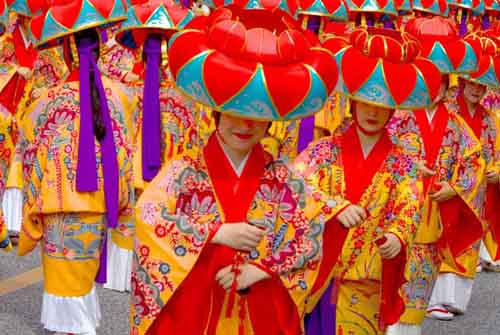Mele Murals is a series of murals across the state of Hawaii, based on local songs or legends. The mural is a collaborative project, bringing together students, professional artists, musicians, and cultural advisers to create a work that will be inspired and treasured by the community. Mele Murals is a 5 year project, backed by the
Estria Foundation. Waimea's piece, on the side of
Kahilu Theatre, is the first on Big Island.
 |
| artists Prime (far left), Kanoa Castro (second to left) and Estria (far right) |
This project was brought to Waimea by Kanoa Castro (second from left), a local artist and teacher at
Kanu O Ka Aina Public Charter School who happens to also be a Pūnana Leo parent. Its a credit to the entire town that this project was completed in just four short days. My favorite part was seeing the upper school students from Kanu, who were so moved to stand in the presence of their creation they could hardly contain their tears. That is something I will likely recall each time I walk by this wall.
The students from Pūnana Leo and ʻAlo Kēhau helped paint and performed at the unveiling, both a
hula and
oli from the murals' theme.
Nā Puʻu Kaulana o Waimea
The first wall is based on the song Nā Puʻu Kaulana o Waimea (The Famous Hills of Waimea). Each district in Hawaii has its own special something - an answer to that infamous question "who are you?" - and here in Waimea ours is most definitely these beautiful, rolling hills. This mural also calls attention to our watershed, the connection between the hills and the fresh water we all need to survive.
 |
| this image is inspired by the Kumulipo, the Hawaiian chant of creation |
One of my favorite details in this panel is the ghostly
Kīpuʻupuʻu warriors in the upper right-hand corner.
Kīpuʻupuʻu is another "Waimea thing", its a name for the slanted, whipping rains that sting your skin and chill you to the bone. Kamehameha's most elite warriors were bestowed with that same moniker. These warriors from the past, being led by the light of their chief, are coming down from the clouds just like their namesake.
Hole Waimea
Hole (hoe-leh) Waimea is a chant that also talks about the Kīpuʻupuʻu rains. The dramatic slant of these drops references that fierce rainfall. The drops showcase different flora and elemental features significant to this region.
In the bottom left we see the well-known story of Manaua (
whose basking rock you can visit in town), the
moʻowahine of Kohākohau stream. According to my son, if you want to swim in a pond (her pond?) you have to place a ti leaf on the water. If the leaf floats, go ahead and swim. But, if it sinks, Manaua is there and she will capture you.
 |
| shoot! The logo got cut off :( I'll have to repost a better photo later |
I love this beautiful detail of the red lehua blossom, which is the flower for our island. Below the lyrics, there is also an emblem from
Idle No More. Kanu students came up with this logo and have used it for many demonstrations related to Hawaiian issues, but the one that stands out in my mind is the recent protests to further construction on Mauna Kea,
specifically the TMT. I'm happy they included it in this mural as a testament to the fact that we should continue to speak out in support of what we believe.
Mālana Mai

The words for this chant came from the journals of Queen Emma as she took a trip around the island of Hawaii. They were later put into chant form and this
oli is now used for the Makaliʻi, which is
our local voyaging canoe based out of Kawaihae Harbor.
There is so much awesomeness going on here, Iʻm not sure where to start. The chant talks about how the different districts of Hawaii island coming together. Here, on the left side in blue, there is
makawalu or "eight eyes", which is an idiom that means to see things from many perspectives. You can see the shape of Mauna Kea, the white snow cap of Poliʻahu, the koholā (whales), the rainbows, the sunshine, the dark night...so many aspects that come together to create Hawaii and her culture.
There is also, in this mural and Nā Puʻu Kaulana o Waimea, a specific starline depicted in the night sky. Polynesian voyagers use these starlines to navigate the open ocean without any GPS or even a compass. I can't remember the name of the line they used here, but I do know that the constellation Makaliʻi (aka Pleiades) is up there somewhere.
 |
| The 3 pikos - past, present and future |
Let me just say that when we went out with the kids to paint it was raining. Not just any rain, a full-scale deluge. The kind of rain only Waimea could be proud of. I was horrified on Monday to see the paint being so lovingly applied then just sliding down the wall into a sloppy puddle on the sidewalk. I crossed my fingers that they would get at least one nice day so the paint would have time to...I dunno, stay on the wall at the very least! The next three days were perfect. In fact, it didn't rain again until the unveiling, which seemed so appropriate. They left a tasteful sampling of the runny smears and streaks, which will always remind me of that "miserable" afternoon. This mural was so collaborative, even our weather got a hand in its creation!
 |
| the lovely, drippy, scales our children so gleefully painted <3 |



































